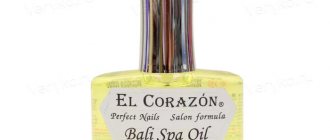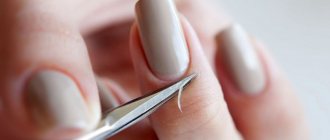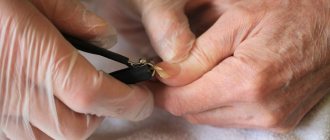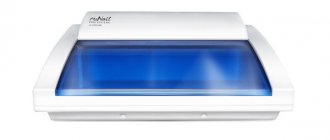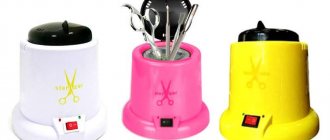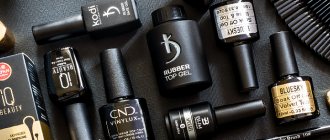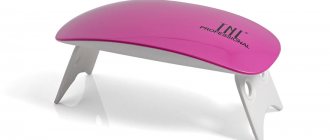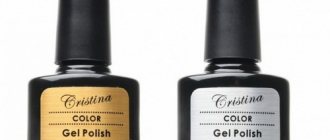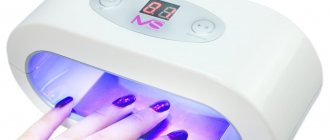How to cut toenails correctly?
Before cutting your toenails, you need to carefully prepare them for this procedure. First, you should thoroughly wash your feet with any toilet soap . Next, all dirt is removed from under the nails . It is also necessary to remove the varnish . If your nails have a gel or acrylic coating, then you need to remove it according to all the rules.
It is advisable to make a foot bath based on sea salt or chamomile. The skin of the nail bed will be moisturized, and the nail itself will become more pliable. After the bath, your feet will need to be dried with a towel for 15 minutes. Now you can move on to cutting your nails.
Toenails should be trimmed carefully as they are usually prone to ingrown nails. The reason for this is not only improper cutting of nails, but also wearing tight shoes, injuries and fungal infections.
Toenails should be cut perpendicular to the cuticle, strictly in a straight line, without bends or rounding . Why shouldn't you cut off the corners of your nails? This will cause them to change the trajectory of their growth and begin to constantly grow.
There is also no need to cut your nails too deep, especially on the sides. With proper trimming, there should be a free edge of the nail - 1-2 mm , protruding beyond the space of the nail bed. After the procedure, you can apply a moisturizing cream to the nail and softening oil to the cuticle.
The average growth of a person's toenails is 4-5 mm in one month. This is an average figure that can vary significantly from person to person. Much depends on age, health status and even the time of year. With regular care, you need to cut your toenails at least 2 times a week .
To cut your toenails, you can use manicure scissors, pedicure clippers, or a nail clipper . Also, this procedure cannot be done without a nail file or tweezers for removing burrs. All these tools must be personal to avoid becoming infected with fungal diseases. Before the procedure, you need to treat them with an antiseptic or sterilize them. For these purposes, you can use hydrogen peroxide, an alcohol solution, or chlorhexidine.
Application
Nippers can be used to treat toenails and fingernails. First of all, they are used to quickly remove excess nail length. It takes a long time to file a long nail with a file, so it is simply cut off. If the procedure is performed carefully and with high-quality tools, it will not harm the nail.
Most often, pliers are used to cut off the fingernails of men, as well as the toenails of both men and women. This is due to the fact that these nails are thicker and more difficult to file with a file. In addition, they are quite difficult to damage.
Another area where nail clippers are used, as in the photo, is nail extensions using tips and removing extended nails. When doing extensions, this tool is used to trim tips to the desired length. But it is also indispensable when removing them, as well as shellac or gel. Before you begin the procedure for removing extended or gel-coated nails, they should be cut as short as possible. This is what nippers are used for.
Types of wire cutters
Knipser
There are several types of pedicure nippers, depending on their area of application. There are cuticle nippers, and there are nippers directly for nails. With the help of the latter, it is easiest to trim nails and remove hangnails. You can't do without pedicure clippers when working with rough, keratinized nails. They are practically no different from manicure ones in appearance, but have a stronger folding spring. Pedicure clippers may vary in size. Thus, a tool for cutting nails for men is always larger than a nail clipper for cutting a child’s nails.
Today, pedicure clippers are divided into the following types:
- Professional - made from surgical steel of the highest quality, as they are repeatedly subjected to heat treatment during the work process. These nippers will not need to be sharpened for several years.
- Knipsers are a compact type of nippers. This tool has a cutting edge for cutting the nail at an angle of 90 degrees. Unlike large tools, it allows you to get close to even small, curved nails. The sharpened cutting surface of the nail clipper makes it easy to trim the nail, preventing it from splitting. Ideal for use on brittle, peeling nails.
- Ingrown toenail clippers are a tool that is specifically designed for the treatment and correction of ingrown toenails. It has an elongated and thin cutting surface. Made from the highest quality stainless steel.
- Pedicure nippers for older people are a tool that is designed to work with thick and hard nails. Also suitable for nails affected by fungus. These are the nippers that are needed to give an elderly person a pedicure at home. Most of these cutters are made of carbon steel.
Nippers for ingrown toenails
See how to choose the right professional pedicure nail clippers:
How to care for nail clippers
To ensure that your manicure is always of high quality and safe, and that the tool lasts as long as possible, there are a few simple recommendations.
The working process
- When working, always place the tweezers with the cutting part facing up. Do not throw them with the sharp blade facing down, this will avoid scratches and nicks.
- Before starting work, grab the tool with your palm on top, then turn your hand over. The index finger should be under the running gear and not too close to the blade, and the thumb should be on top of the running gear. The remaining fingers should be located along the line of the left handle (for left-handed people - vice versa).
- Always position the pliers with the blade facing away from you and the client to avoid accidental injury.
Care, sterilization and storage
- Store your cutters in a protective silicone or plastic cap and case. After sterilization, place them in a craft bag. Never store metal tools in damp or damp conditions. The recommended indoor temperature according to SanPiN is from 21°C, and humidity is 40-60%.
- Each instrument has its own individual characteristics. When disinfecting and sterilizing, be sure to follow the manufacturer's recommendations so that the instrument lasts longer. Pay attention to the proportions for preparing the disinfectant solution, the recommended exposure time in it and the temperature during heat treatment.
- After sterilization, it is recommended to lubricate the nippers with oil - 1 drop on the contact surfaces.
Sharpening
- If the tongs become dull or fall with a sharp edge onto a hard surface, they must be immediately sharpened or repaired to restore the geometry of the head, blades, and joints.
- If you work in a salon, it is recommended to sharpen the tongs at least once every six months to a year, depending on the flow of clients. When used at home, a professional tool can last about 3-5 years without the need for sharpening.
- Give the nippers to a specialized service; do not experiment with sharpening at home. This can damage the instrument, sometimes beyond repair.
Follow these rules, and you will be guaranteed long-term comfortable work with pliers.
Now let’s sum it up in a short checklist! Imagine that you come to a store of tools and materials for manicure. These simple questions will help you make the right choice.
Requirements for pedicure instruments
Ideally, cutters and clippers should meet the following requirements:
- professionally sharpened by hand;
- made of stainless medical steel;
- must have a smooth ride that does not bounce;
- their surface should have smooth cutting edges;
- should have a comfortable grip for left and right hands.
If the blades of the clippers are well sharpened, then they will easily cope with nails of any thickness and hardness, cutting the nail plate perfectly evenly, without delamination.
Best Cuticle Nippers
The selection is based on reviews and the test of time.
- Stalex Exclusive 20, 8mm. The length of the blade is 8 mm. This company's cuticle nippers are some of the best on the market. Features of the model: Soft and clear closure, precise cut, manual sharpening, increased resistance to corrosion due to polishing to a mirror effect. An excellent choice for professionals. Beware of fakes, order only on the official website or in trusted stores.
- Stalex expert 71. Blade length 9mm. Smooth and easy movement, an extended view of the surface, perfect closure and sharpness, everything you need for comfortable work and an ideal result. The model has long handles.
- Yoko SK 007. Blade length 5.5 mm. Miniature, convenient nippers made of Japanese steel, suitable for beginners. It has high strength, resistance to wear, and all types of sterilization treatments.
- Mertz 1560. Blade length 7mm. They are characterized by a very smooth operation and convenience due to the average length of the cutting blade. They have a double spring. They are famous for their long service life.
- Solinberg 222-504. The length of the canvas is 7-8mm. This model is made in Germany. Suitable for craftsmen with any experience. Thanks to laser processing of cutting edges, they can be used for a long time without loss of quality. The price is relatively low, and the design in the form of relief on the handles will be appreciated by any craftsman.
How to choose pedicure clippers?
Pedicure nippers may differ in material, blade shape, and quality of sharpening. The price of the instrument depends on all these indicators. Also, tools from well-known brands are many times more expensive. But this justifies their high quality and long service life. Therefore, there is no need to save money.
The highest quality pedicure clippers are made of stainless steel . Such a tool will hold an edge perfectly and will not bend or break during operation. In addition, stainless steel nippers can be sharpened many times and can also be sterilized in any sterilizer.
When choosing between factory and manual sharpening of wire cutters, give preference to the latter. Factory sharpening is much inferior to manual sharpening. With it, the blade usually does not sharpen evenly, and burrs may appear. If sharpened by hand, the tool blade will be perfect, without burrs, and will last much longer.
Some people don't see the difference between manicure and pedicure clippers. But the latter are usually somewhat wider and better sharpened.
Instrument care
Nail clippers, whether used for manicure or pedicure, require careful care. Although they are intended exclusively for nail plates, there is still a possibility of damaging the skin with them, especially during manicure. Therefore, this instrument must be thoroughly sterilized. This can be done using a special solution or by placing it in a sterilizer, thermal or infrared.
It is better to purchase tongs in a cap, case or case. This will keep their blades sharp for as long as possible and also prevent them from breaking if dropped. In general, you should handle them with care, since even a fall in a case and from a small height can lead to breakage of the instrument. Also, when storing, place the release spring so that the blades do not touch each other.
To extend the service life of the tool, it must be periodically lubricated with technical or machine oil. This can be done once a month, since if the connection of the parts of the pliers starts to get stuck when closing and opening, this will affect not only the comfort of work, but also the longevity of sharpening.
Best models
All pedicure nippers and knipsers can be divided into several categories. Which ones to choose? The most common and popular of them include instruments of the following brands: Singer, Merz. The quality of these cutters is approximately the same. They are produced in China. They are ideal for working with non-thickened healthy nails.
Nippers from the following brands are suitable for hard nails Credo Solingen and Stalex . German and Russian brands are ideal for solving the problems of aging nails. These cutters are made from the highest quality steel that has undergone special heat treatment. They feature a well-sharpened blade.
If your nails are thick or very hard , then you should take a closer look at the products of the Wuesthof Solingen . These tools are made of carbon steel. The pliers of this brand are very comfortable to hold in your hand. They are suitable for working with even the most problematic nails.
Learn how to choose the right nippers with a professional:
Types and selection criteria
One of the top tips is to research cuticle nippers before purchasing. And very carefully. Therefore, it is better to go to a specialized store rather than online. This begs one of the main questions: how, in fact, to choose the right one and how to research them before purchasing? We answer:
- The material of this work of art should be called "medical steel". Or make sure that the material marking looks like this: “40x13”. The first number means the density, and therefore the hardness of the steel, and it should not have a value less than 40. More is allowed.
- The joint of the forceps must be made of ideally and as tightly as possible fitting and polished parts.
- Take the cuticle clippers in your hands and check them for play by moving the handles in different directions. If the seller begins to faint or take them away from you, explain that normal cuticle nippers will never be damaged by such treatment.
During the checking process there should be no clicks, the parts should move smoothly, and not tight or, on the contrary, loose. Do not expect that the mechanism “diverges” during operation.
Make sure that the handles open to their full amplitude, all the way, without effort on your part. And that they converge without changing the smoothness of movement with the same effort. And of course the handle should not fall under its own weight.
- Make sure that it will be comfortable for you to work with, that the handles fit snugly in your hand and will not slip out. Move them 10-12 times and make sure that your hand does not get tired quickly.
- The best return mechanism is 2 springs formed into a spiral. One or two simple springs are a little worse.
- There should be no gap between the cutting edges, and the thickness of the “jaws” should be 0.3 millimeters.
- The tips must be the same length - even the slightest deviation will affect the result of the work.
- The length of the blade itself for professionals should be 7 millimeters, for ordinary people - up to 5 millimeters. We explain: trained masters can control the process and successfully manage a longer blade. This speeds up the work, and in this case, the nippers will last much longer, because a layer of steel is removed each time when turning. These 2 millimeters will extend the service life by 10 years. We and everyone who will use them at home and will not undergo prior training will be able to work without bruises and burrs with a shorter blade. If we take into account that we will do a manicure once a week, and not 5 times a day, then under such conditions and sharpening once a year, a shorter blade will also last for a long time.
- Check all gaps for clearance. Please note: the working ends must meet, starting from the ends to the base.
- We do all the manipulations by retracting the springs of the return mechanism, regardless of whether we use them.
- We check the level and quality of sharpening: take a thin plastic bag and cut through it. Even with the slightest pressure, the cut should be uniform and clear along the entire length of the blade. Make sure you don't press too hard. Incorrect turning will ruin even the best cutters, so make sure there is a workshop in your city that can do this kind of turning.
The remaining parameters - plastic or silicone tips on the handles, a handle in the form of scissors, and so on - are secondary. It depends on your personal preferences. And even the price is not decisive.
Failure to meet the main selection criteria promises you or your customers disappointment from the purchase due to inconvenience in use, the appearance of burrs, wounds and the need to frequently sharpen them.
How to use wire cutters correctly?
There is no need to cut the entire nail width at once using clippers. This needs to be done in several steps. First, the side parts are cut, then the middle. It’s worth doing everything in this order because nails usually don’t have a perfectly flat surface and can simply crack if cut at once.
shorten the corners at the edges , especially if they are prone to ingrowth, by rounding them a little . In this case, it is best to trim the free edge of the nail perfectly straight, then you can get a shape suitable for a French manicure.
After completing the circumcision procedure, you should straighten your nails with a file . It is best to take a ceramic or glass file for this purpose.
If you have already learned how to use pedicure clippers, master the full course of classic trim pedicure:
Choosing the best nail clippers
Nail clippers differ from their cuticle counterparts in the type of blade and sharpening. And the instrument itself is more massive and durable, because it has to work not with thin leather, but with denser material.
Nail clippers replace nail scissors and are used to trim the nail plate, change its shape, and remove ingrown nails. The size of the blades of such tweezers is 10–15 millimeters (pedicure models are 15–25 mm long).
As with cuticle tools, choose products made from steel. For comfort while working with them, you can purchase a model with rubber or silicone handles. Before sterilization, these pads are removed and cleaned with a disinfectant.
When choosing, follow the same tips as when choosing a model for the cuticle, but consider a special tool for processing the nail plate specifically. If you have any doubts when choosing, contact the store consultants. Experts will tell you about the benefits of a particular product and help you buy the ideal option just for you.
How to sharpen correctly
All steel tools sooner or later become dull, so you have to resort to sharpening. This lesson will tell you in detail how to sharpen nail clippers. Sharpening is done using one of the following techniques:
- manual method;
- factory method.
Hand-sharpened tongs are much sharper and will last longer. Manual (individual) sharpening is done by a master using a diamond stone. To properly sharpen scissors or forceps, you will need to use a microscope. The factory method is performed on machines with diamond wheels in specialized class=”aligncenter” width=”1154″ height=”371″[/img]
Factory sharpening leads to the fact that the tool does not cut over the entire area of the blade, which is not entirely convenient for the master. An experienced specialist should sharpen tweezers using the following sequence of actions:
- If the tweezers have play, it must be eliminated first.
- After repair, the spring is adjusted and rust is removed from the surface of the tongs.
- The joints of the handles are lubricated.
- After this, the nippers are sharpened from the inside, first one then the second plane.
- At the end, the corners of the nose are sharpened and polished.
If you need to sharpen nail clippers at home, you will need:
- Device for sharpening knives (sharpening machine).
- Sandpaper, which is fixed to a nail file.
- Foil, folded several times and cut into strips.
You can sharpen a tool at home in the following sequence:
- Buy a diamond wheel for your sharpening machine.
- Spread the blades as far apart as possible and move their inner surface around the rotating circle.
- Do this procedure twice on each half of the tongs.
- Clean the surface of the tongs with a thick cloth.
If you don’t have a machine, use blades to cut sandpaper or foil folded several times. This will allow you to sharpen the edge for a short period of time.
